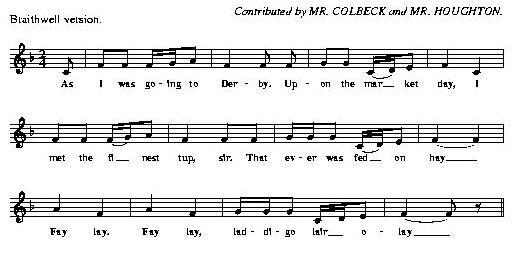Context:
| Location: |
Braithwell, Yorkshire, England (SK5394) |
| Year: |
Perf. 1895 |
| Time of Occurrence: |
[Not given] |
| Collective Name: |
[Not given] |
|
Source:
Ivor Gatty
The Old Tup and its Ritual
Journal of the English Folk Dance and Song Society,
1946, Vo.5, No.1, pp.24-26
|
Cast:
|
Text:
{The performance opened with the Old Man and the Old Woman knocking at the
door of the house and reciting the following introduction:-}
[Old Man and Old Woman]
Here comes me and my owd lass,
Short of money, short of brass ;
Fill up your glass, give us a sup,
We'll come in and show you the Derby Tup.
{If permission were granted the troupe marched in. The farmer had the tup on a
halter, and there was a bit of comic business with it trying to escape, and charging
the audience, etc. Then the singer began the verse, all the company joining in the
chorus, including one or two supernumeraries who were allowed to accompany the
troupe and stand in the background.}

[MIDI music sound file] [ABC music notation]
[Singer]
As I was going to Derby.
Upon the market day,
I met the finest tup, sir.
That ever was fed on hay.
[All]
Fay lay. Fay lay, laddigo lair-o-lay.
[Singer]
This tup was fat behind, sir,
This tup was fat before ;
This tup stood nine foot high, sir,
If he didn't stand no more.
[All]
Fay-lay etc.
[Singer]
The wool that grew on his belly, sir,
Was trailing all around ;
Every foot the tup set down, sir,
He covered an acre of ground.
[All]
Fay-lay etc.
[Singer]
The wool that grew on his back, sir,
It grew so mighty high,
Eagles came and built their nests, sir,
You could hear the young ones cry.
[All]
Fay-lay etc.
[Singer]
The horns that grew on his head, sir,
They grew so mighty wide,
That a coach and six could go betwixt
With a footman by the side.
[All]
Fay-lay etc.
[Singer]
The butcher that stuck the tup, sir,
Was in danger of his life.
He was up to his knees in blood, sir,
Crying out for a longer knife.
{The butcher here acted the part}
[All]
Fay-lay etc.
[Singer]
The blood that run from this tup, sir,
It run down Derby moor,
Turned the biggest water-wheel
that ever been turned before.
[All]
Fay-lay etc.
[Singer]
And all the boys in Derby
Came begging for his eyes,
To kick about in Derby streets,
For they were football size.
[All]
Fay-lay etc.
[Singer]
And all the blacksmiths in Derby
Came begging for his ears,
To make their leather aprons of,
'Cos they would last for years.
[All]
Fay lay etc.
[Singer]
And all the old women of Derby
Came begging for his bones,
To get the marrow out of them
To nourish their old bones.
[All]
Fay-lay etc.
[Singer]
And now my singing's ended,
We cannot sing no more;
So p'raps you'll give us a trifle,
Or else a glass of beer.
[All]
Fay-lay etc.
|
Notes:
Gatty's Introduction:
"The Braithwell variant. Contributed by Mr.L.Colbeck, aged 66, and Mr.E.J.Houghton, aged 63 ; in an interview at Braithwell on Nov. 8th, 1945. They stated that they both of them had taken part in performances of 'The Old Tup' when they were boys. Mr. Houghton said that his set must have been the very last to go round with it in the year 1895. There were 6 major characters :- 1. An Old Man. 2. An Old Woman. 3. The Tup. 4. The Farmer. 5. The Butcher. 6. A Boy with his face blacked. This last character took no part in the action, he joined in the chorus and that was all, but both Mr.Colbeck and Mr.Houghton were very insistent that he was an essential member of the company. They also laid great stress upon the fact that the words had never been written down, but were handed on from generation to generation by word of mouth."
Gatty's Notes:
"None of the actors wore any particular costume, except, of course, the Old Woman and the Tup. This latter was rigged out with a block of wood roughly shaped into a sheep's head, with marbles from old ginger-beer bottles inset for eyes. These were fastened into place with a row of tacks that gave the appearance of eye-lashes. This block was mounted on a broom handle. It was then partly covered with a piece of real sheep's skin, cut from the face, which was supplied by the local butcher. This was more or less dried with salt and tacked into place. Finally a sack was nailed on at the back into which the boy playing the tup inserted his head and shoulders, resting his weight on the pole and pressing his head against the block."
Peter Millington's Notes:
This text is reproduced with the kind permission of the English Folk Dance and Song Society.
|
File History:
2004-07-26 - Scanned, OCRed and encoded by Peter Millington
2021-01-15 - TEI-encoded by Peter Millington
|
Extras:
TEI-encoded File
A TEI-encoded XML version of this text can be downloaded here.
Other Information
There may be more about this text at:
https://folkplay.info/resources/texts-and-contexts/old-tup-braithwell-1895.
|
|